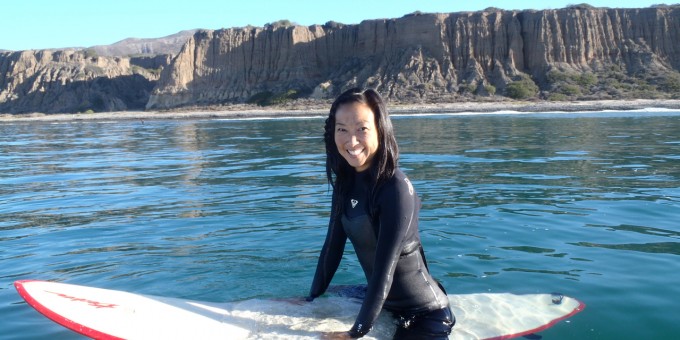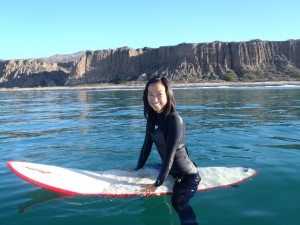
It is easy to like something when you are naturally good at it, and it is easy to walk away from something when you are not. Enjoying something despite not being good at it requires a particular mindset. This describes my relationship with surfing. I am not a good surfer (at least not yet), but by adopting a growth mindset, I have come to enjoy it immensely and relish in the challenge of improving in the sport.
The first time I really noticed surfers was during a vacation in Sayulita, a village about 25 miles north of Puerto Vallarta, Mexico. I would begin each morning in Sayulita with a run on the beach, followed by an hour or so of gazing at the local surfers, some of whom would awe the onlookers by doing handstands or walking their toes to the nose of their boards. It had not occurred to me that all of the surfers were male until one morning, I saw a female surfer in the lineup. Riding among the males, she stood out, but looked athletically fierce and rode and carved the waves as adroitly as her male counterparts. Seeing a female surfer—such a skilled one, at that—inspired me. As soon as I returned home to Orange County, I booked my first surf lesson.
My surf instructor was a 17-year-old high school junior named Ryan, who grew up in Laguna Beach, CA, and had been surfing for as long as he could remember. He showed me the board that I would ride: a long, wide, thick, foam soft board that looked nothing like his short, sleek, fiberglass board. I knew nothing about the massive variety in boards at the time, so Ryan explained that the foam board was perfect for beginners—it is constructed to be very buoyant and stable, making it easier for beginners to catch a wave, pop up, and ride. After some instruction on the beach about paddling and popping up, I followed Ryan into the water.Ryan made surfing downright easy for this novice. All I had to do was lay on the board as he kept an eye out for waves, told me when to begin paddling, pushed me into the wave, and then told me exactly when to stand up on and ride. To my surprise and sheer delight, I popped up and rode the first wave I caught, all the way into shore! (Apparently, I was supposed to have jumped off the board before it reached the shore, but we hadn’t covered that yet.) After an hour with Ryan, I had ridden several waves, and he applauded my natural ability. I was left reeling with pride. Surfing, it seemed, just came to me.

After a few more times on a borrowed foam board, I was anxious to buy a fiberglass board of my own. Boards are visible signs of a surfer’s skill level; as a general rule, the shorter, narrower, and thinner the board, the more skilled the surfer. Smaller, fiberglass boards are less buoyant and less stable, though they’re easier to maneuver than bigger, steadier foam surfboards. So, against the advice of my friends, I persisted in buying a shorter board; I was convinced my surfing skills would rapidly improve to the point where I could ride my the 6’ 9” Becker board I brought home.
I took my new ride down to Trails in San Onofre State Beach. While paddling out was not difficult, trying to catch a wave and pop up proved excruciatingly challenging. And after two months of trying, I still could not catch a wave. I would paddle as hard as I could, try to get to my feet, fall off immediately, and get tossed around by the undercurrent. I repeated this sequence with no success, to the point that I no longer enjoyed surfing and began to believe that I lacked the skills the surf, despite my earlier successes. I was no longer having fun and lost confidence. I hung up my wetsuit and retired my surfboard. Frankly, had it not been for the regular dolphin sightings during my “surf” outings, I would have given up a lot earlier.
Then, last year, while living in New York, a colleague pointed me to Carol Dweck’s research. A social psychologist at Stanford, Dweck is author of Mindset, in which she explains that people can have different mindsets about their talents and abilities. Some believe their talents and abilities are innate, fixed traits—what she refers to as “a fixed mindset.” Others believe their talents and abilities can be developed through effort, perseverance, and mentoring—what she describes as “a growth mindset.”
Dweck found that the type of mindset a person adopts affects how they handle challenging tasks. People with fixed mindsets shy away from challenges because they feel that if they fail at the task, they will reveal a deficiency in their talent or ability. By contrast, a person with a growth mindset welcomes challenges and the opportunity to become better at something, even if their first attempt isn’t successful. Rather than viewing a failure as an indictment of their talent or ability, people with growth mindsets respond by increasing their effort, learning from their failures, and forging ahead.
There’s also a gender dimension to mindsets. When studying a group of bright, fifth grade students, Dweck found that girls were more likely to have fixed mindsets and boys were more likely to have growth mindsets. For example, when the smart young girls were presented with new and difficult material, they were quick to give up, doubt their ability, and lose confidence. By contrast, when the boys were presented with the same new and difficult material, they were energized by the challenge and increased their efforts to solve the problem at hand. These differences are all the more astonishing because, at the fifth grade level, girls outperform boys on all subjects, including math and science.
So why did these kids react so differently to challenging tasks? Dweck attributes this to the different ways in which adults praise children in school and at home. Because girls develop self-control at an earlier age, they are often lauded for their good performance, praised for being “good,” “smart,” and “well-mannered”—traits that the girls then learn to believe are innate. But because young boys tend to lack self-control, the feedback they receive focuses on what they can do to improve their performance. For example, a teacher may say to a young boy, “If you just pay attention and try harder, you could do this.” So the message that young boys receive underscores the effort required to succeed at a task, while the message that young girls receive highlights their positive results. These different types of praise and feedback affect how boys and girls come to perceive their talent and ability, and consequently affect how they respond to future tasks, especially difficult ones. Because bright young girls are usually praised for performance rather than effort, they are likely to feel they’ve failed if they do not perform well. They are then more likely to shy away from tasks that present a challenge, fearing they will reveal their inherent, “fixed” weaknesses.
So can a person with a fixed mindset develop a growth mindset? Yes. Like intelligence, creativity, or athleticism, mindsets are not fixed, and if we jettison the idea that ability is innate, let go of the fear of failure, we can improve our skills in domains in which we believe we lack talent. We may never reach the stature of Albert Einstein, Steve Jobs, or Kelly Slater, but we’ll become better at whatever it is that we are trying to achieve. Even Einstein, Jobs, and Slater, after all, achieved success after decades of effort.

Armed with my new knowledge about the growth mindset, I returned from New York determined to ride a wave. I dusted off my surfboard and paddled out in the ocean once again, this time armed with a different take on failure. It has been three months now since I got back onto my board, and I am still nowhere close to where I would like to be. While I am skilled enough to catch a wave and body surf my board, each time I pop up, I am only able to ride the wave for a few seconds.
There are a number of barriers that keep females from entering the world of surfing that have nothing to do with physical capability: the exclusively male line-up I typically face each time I paddle out; the unwelcome reception by locals who guard “their surf spot”; and a dearth of female role models and mentors who can teach other women. Each obstacle sends a sharp signal to an interested woman that she does not belong on a board, that females are not good surfers. Perhaps worse, because surfing is so male-dominated, female surfers may suffer from “stereotype threat,” that is, the threat or the fear of performing in a way that would inadvertently confirm a negative stereotype of one’s group. That fear weakens their performance. Females face enough challenges getting on a board and riding a wave, but a fixed mindset need not be one of them.
Now, rather than becoming dejected or giving up, I have decided to adopt a growth mindset when I head to the water. In doing so, I have learned to appreciate the subtle improvements I make. For example, I have learned to turtle roll oncoming waves; I am unafraid (although respectful) of overhead-sized waves that come barreling down on me; and I have learned how to balance on, steer, and stop my board—skills that are essential for surfing. All of these reflect the effort that I’ve put in each time I paddled out. Someday, I would love to surf like the woman who inspired me in Sayulita, but for now, I am reveling in the fruits of my effort and letting go of the result. Consequently, I have discovered a new joy of surfing—one that is about the process—and a change in mindset.
Recommended Reading
Carol Dweck. 2006. Mindset: The New Psychology of Success.
Carol Dweck. 1999. Self-Theories: Their Role in Motivation, Personality, and Development.
Louise Southerden. 2005. Surf’s Up: The Girl’s Guide to Surfing.

Comments 4
uggen — November 2, 2012
The imagery and details in this essay are really evocative -- especially for the landlocked in November. It seems like the surf guitar genre is still pretty dude-heavy (http://www.youtube.com/watch?v=T8__EwAT8VM), but bands like The Trashwomen might be breaking down the barriers -- http://www.youtube.com/watch?v=jI3XM-X72eQ ...
AShley — December 1, 2012
As a sociology student, female surf instructor, and (coincidentally from Orange County), I can wholeheartedly say that I've noticed pretty clear patterns in the behavior and attitudes amongst men and women in the water. This phenomena starts YOUNG too. I've worked with girls as young as 6 who need a lot of coaxing and reassurance (compared to most boys who often excitedly run straight into the water without hesitation).
I'm glad there is an academic explanation for this!
hard working gals — December 15, 2012
Not sure that this girl-boy motivation theory holds.
Isn't there mounting evidence that women tend to work harder towards their chosen goals than men, for instance in college, resulting in better grades and more advanced degrees?
The Personal is Sociological » The Editors' Desk — November 7, 2013
[…] Indeed, we’ve had some wonderful examples on our site—Jenn Lee’s reflections on gender and privilege, for example, or Joel Best’s changing views on Social Security in the context […]